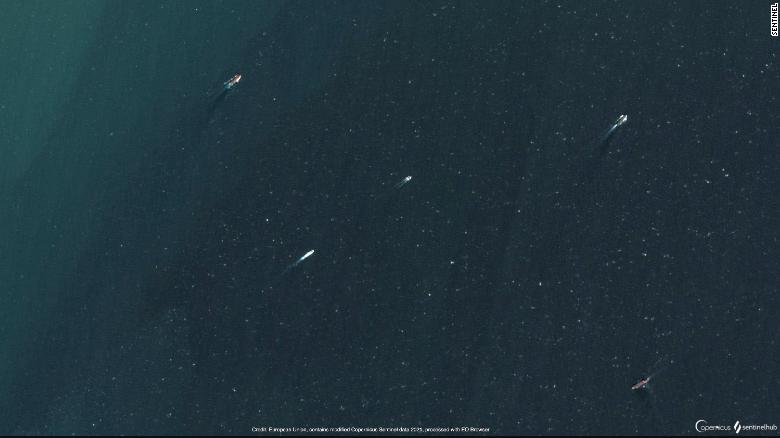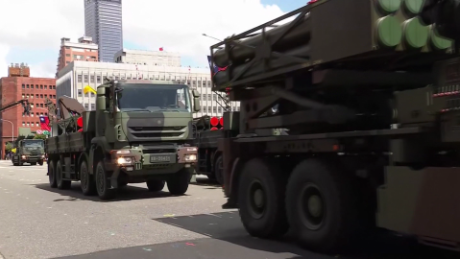begin quote from:
https://www.cnn.com/2021/12/03/asia/taiwan-strait-china-submarine-mic-intl-hnk-ml/index.html
Chinese submarine's alleged surprise show highlights risk of the unexpected at sea

Analysis by Brad Lendon, CNN
Updated 2:49 AM ET, Fri December 3, 2021

An image from European satellite imaging company Sentinel 2 shows what analyst HI Sutton says is a Chinese submarine in the lower left.
A version of this story appeared in CNN's Meanwhile in China newsletter, a three-times-a-week update exploring what you need to know about the country's rise and how it impacts the world. Sign up here.
Hong Kong (CNN)The unexpected appearance of an alleged Chinese submarine in the Taiwan Strait this week has highlighted the dangers posed by the frequent presence of military vessels in the narrow waterway, which analysts warn could ultimately spark an unintended conflict.
Writing on the Covert Shores blog Monday, submarine expert H.I. Sutton identified the vessel as a Chinese Type-94 nuclear-powered ballistic missile sub in a photo from the open source European satellite imagery service, Sentinel-2.
The sub was spotted allegedly cruising above the surface of the waters separating Taiwan from mainland China, where many analysts say conflict is more likely to start from an accidental collision than a planned event -- and the more warships in a confined space, the more chances there are for accidents to happen.
The reason for its alleged presence in the strait is unknown, but Sutton said it was likely the Chinese sub -- also known as an SSBN or boomer -- was on a routine mission, possibly heading back to a People's Liberation Army (PLA) Navy port on the Bohai Sea for repairs or maintenance.
But other experts who viewed the satellite image said the alleged presence of a boomer on the surface was perplexing.
"An SSBN on the surface is all but unheard of," said Carl Schuster, an ex-US Navy captain and former director of operations at the US Pacific Command's Joint Intelligence Center. "This may suggest a hull or engineering problem that requires a major shipyard to investigate and fix."
The Taiwan Strait is just 110 miles (180 kilometers) across at its narrowest point. It has become one of the world's military hotspots as China puts increasing pressure on self-governed Taiwan, which Chinese President Xi Jinping has vowed to bring under Beijing's control. In response, supporters of the government in Taipei, including the United States, have stepped up their military presence in the region.
This week, the commander of the US Navy's 7th Fleet, headquartered in Japan, said more US and partner aircraft carriers are needed in the western Pacific.
Vice Adm. Karl Thomas, speaking on board the aircraft carrier USS Carl Vinson after large-scale naval exercises involving the US, Japan, Australia, Canada and Germany, said aircraft carriers make a big statement of deterrence.
"When we think about how we might fight, ... four aircraft carriers is a good number, but six, seven or eight would be better," Thomas said, according to a report in the Wall Street Journal.
Meanwhile, China -- which already boasts the world's largest navy by number of ships -- is continuing to churn out new naval vessels.
In November, its fourth Type 55 destroyer, the Anshan, joined the People's Liberation Army Navy (PLAN) fleet and a fifth is expected to do so by year's end, Naval News reported. The Type 55s are considered to be among the world's most modern and powerful surface combat ships.
And with more ships comes more potential for a mishap, as the US Congressional Research Service wrote last year in a report on the South and East China Seas.
Stepped-up US and Chinese military ship and aircraft operations in the South China Sea "could increase the risk of a miscalculation or inadvertent action that could cause an accident or lead to an incident that in turn could escalate into a crisis or conflict," the report said.
And in 2018, that's almost what happened when a Chinese destroyer sailed dangerously close to a US guided missile destroyer in the South China Sea -- in what the US Navy described as an "aggressive maneuver." The two ships came within 45 yards (41 meters) of each other, according to US Navy reports.
But Taiwan and its supporters are not standing still. Taipei last month started construction on the first of a planned eight indigenously built submarines.
Australia, a vocal supporter of Taiwan and critic of Beijing's increasing military pressure around the region, said earlier this year it plans to build a fleet of nuclear-powered subs.
Japan in October launched the second boat in its new class of diesel-electric submarines. The first in the Taigei class is expected to be commissioned in March.
The potential for collisions at sea was brought into focus in October, when a US Navy sub, USS Connecticut, struck what the US Pacific Fleet said was an undersea mountain in the South China Sea. The Connecticut, a nuclear-powered fast attack sub, limped on the surface back to the US naval base on the Pacific island of Guam after that incident. And in 2017, a spate of US Navy accidents in Asia raised similar concerns.
While there has been no indication the alleged Chinese sub spotted Monday suffered an accident, "it is an interesting mystery," said Schuster, who also noted the PLA could have simply been showing its muscle in the strait, as the US and its partner navies have done recently.
CNN has reached out to the Chinese Ministry of Defense and Ministry of Foreign Affairs for comment.

No comments:
Post a Comment